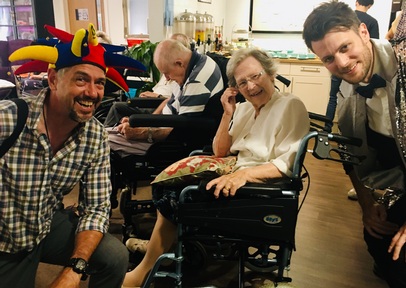Bridging the communication gap – how care workers can help those with hearing loss
Whether you suffer from hearing loss yourself or are a care worker helping people who live with this frustrating and isolating condition, the practical advice offered by hearing loss management courses can be invaluable in easing communication problems.

Hearing loss is now suffered by more than ten million people in the UK and, of these, more than half (6.3million) are over 50. It is projected to rise to 14.5m people by 2031. As research from charity Action on Hearing Loss has revealed the take up from care homes to install suitable procedures and equipment is low to say the least. No exact figures are available, but it seems that very few care homes have a set of procedures or even equipment in place to deal with and support hearing loss.
But whether it’s a care home or care worker, coping with hearing loss is not just a matter of supplying people with the latest hearing aids and maintaining those aids. As Lorraine Gailey, chief executive of Hearing Link, a leading charity dedicated to helping those with hearing loss cope with their disability, says: “While it is absolutely true that the technology is important, knowing some practical solutions to the problems of hearing loss are equally, if not more, important.”
For a condition that affects millions of people both in and outside care homes, there are all too few organisations that offer practical self-help advice. Hearing Link runs a variety of courses ranging from intensive rehabilitation and befriending programmes to a self-management course that takes place over three days (one day a month) and aims to help those with hearing loss improve their communication and feel more confident. At the moment, the charity mainly helps individuals with hearing loss but would be only too happy to take the course into care homes.
Down-to-earth approach
Laura Turton, head of services at Hearing Link, says: “We aim to provide people with a tool box so they can choose what works for them.” As well as helpful ‘tools’, not least is the sense of relief that many experience when they attend and realise that they are not alone.
Hearing Link’s self-management programme is aimed at people with any level of hearing loss and their partners or care workers are welcome to attend too. Initially, it starts by encouraging people to describe their experiences of living with hearing loss and define what they wish to achieve before tackling such topics as ways to communicate more effectively, ensuring personal safety, building confidence and managing the sheer frustration of being deaf.
Throughout the course, attendees are given up-to-date information on the latest technological gadgets that may help them (some of which are obtainable free of charge from Sensory Impairment Services) and useful information on such things as the text service people can register to use when and if they use emergency services, and the fact that RAC has a loop system on its emergency phones to be found on the motorway.
All too often, people are not aware of the many types of useful equipment that are available. For example, there are now stage text theatre and subtitled cinema performances available for those who are more mobile and specialist websites have information on when these performances are available locally (see Hearing Link’s website).
Central to the course is a session on relaxation. Living with hearing loss is tiring because so much effort is expended on trying to hear, so relaxation is important and people with hearing loss should aim to spend some time unwinding every day. For some people, using another sense can help relaxation – such as smelling lavender, for others it’s simple techniques such as visualisation or breathing exercises.
Tips for people with hearing loss
One of the most common and frustrating problems experienced by those with hearing loss is the fact that a person can hear, but can’t discern what’s being said when talking to members of the family, is outside the home (for instance at a supermarket) or when in a social group.
Advice is given as to how to tackle any given situation. For example:
• If you cannot hear the amount being asked for your shopping at the supermarket – ask the girl at the checkout to turn the screen round so that you can see the monitor.
• How to build up your confidence to tell people what they can do to help make communicating easier. Tell others how you prefer to be alerted to the fact that they are talking to them, perhaps by a wave of the hand.
• Rather than always asking for something to be repeated. Learn to ask closed questions that also help to move the conversation on. Ask “Did you say that was fourteen pounds, that is one four pounds?” To which the answer is ‘yes’ or ‘no’, which is easier to understand than trying to decipher the answer to “Does it cost ten or fourteen pounds?”
Tips for care workers and care homes
Many of the hints and tips outlined are also of great use to those who are caring for people with hearing loss. Even care workers who are accustomed to the condition, sometimes forget to do such things as:
• Making sure the person with hearing loss can see their face and mouth easily when they are talking, not trying to talk to them from another room, turning the television down, going somewhere quieter to hold a conversation, having a pen and paper to write things down if necessary.
• Slowing down the speed at which they talk while keeping the rhythm going, talking in sentences (single words are difficult to lipread), not shouting, speaking clearly with sufficient volume, patiently repeating something, rephrasing sentences or changing words that may be difficult to lipread.
• Rooms with soft furnishings, curtains and carpets that prevent sound from echoing, make life much easier for the hearing aid user and good lighting aids lipreadingfor this reason, kitchens are not normally the best places to hold a conversation.
• If possible, the person with hearing loss should choose where they sit. Ideally with their back to the source of light so that the light falls on the face of the speaker, that is, make sure that the window or lamp is slightly behind them. Some people find having their back to a wall or corner also helps.
• Dealing with group conversations is challenging to all people with hearing loss. One-to-one conversation is easier. At social gatherings encourage one-to-one conversation for shorter spells and then move on to a new conversation, rather like speed-dating.
Case study: how one man improved his quality of life
John Holliday first noticed his hearing loss after retiring from his job as a consultant. Although the rate of loss was gradual at first, it increased significantly as he approached the age of 75.
When he was first put in contact with an audiologist, John opted for a hearing aid in his left ear. However, soon after his hearing worsened and he had to wear a second, more powerful one.
John encountered the most problems when trying to follow conversations. He said: “The main difficulty was at social events, particularly where a number of people are speaking at the same time. In this situation, it was impossible for me to play an active part in any conversation, leading me to withdraw or avoid such situations altogether.”
Communication was also becoming increasingly difficult at home for John and his wife Brenda, much to their mutual frustration. They decided enough was enough.
John said: “My wife encouraged me to approach Hearing Link for support. She was more aware of my hearing loss than I was because I frequently misunderstood what she said to me. I blamed this on her habit of speaking to me without warning, while I was concentrating on something else.
“This resulted in me missing the first few words that she said and having to ask her to start again. We eventually came to the conclusion that we both needed help in adjusting to the problem.”
The couple attended a self management programme which took place near their home in Stirling. John said: “It helped us to see what was necessary for myself, as well as Brenda, to adjust to and cope together by understanding each other’s difficulties and needs. The communication techniques taught continue to be very useful.
“A major help was being given the opportunity to meet other people with similar problems and hear of their difficulties and how they coped with them.” Since then, John and Brenda have noticed an improvement in communication at home. They have also introduced useful assistive listening devices.
John accepts there will always be some difficulties. He said: “Applying the techniques we were introduced to has made communication more effective. We forget occasionally and go back to our bad old ways, but we soon realise our error. We have to continue using the techniques until they become second nature.
“When we get it right, we are closer to ‘normal’ life. Some problems of course remain; I still cannot cope with noisy environments or people who talk too fast or have high-pitched voices, but removing a significant percentage of the difficulties of being hard of hearing has undoubtedly made life easier.”
This is what a few days of practical advice and support can do, encouraging frustrated and isolated people to change their lives by providing them with a useful approach to communication. May more care workers and care homes set aside time to learn these simple but effective techniques.
For more information on Hearing Link courses see http://www.hearinglink.org/self-management-programme
Latest Features News
 25-Nov-19
2019 Election: Boris Johnson leaves social care in 'too difficult box' but Labour vows to end 'crisis'
25-Nov-19
2019 Election: Boris Johnson leaves social care in 'too difficult box' but Labour vows to end 'crisis'
 18-Oct-19
Podcast: Wendy Mitchell and dementia: 'My biggest fear is not knowing who my daughters are'
18-Oct-19
Podcast: Wendy Mitchell and dementia: 'My biggest fear is not knowing who my daughters are'
 27-Sep-19
Exclusive: Care minister backs care workers' call for time off to grieve and attend funerals
27-Sep-19
Exclusive: Care minister backs care workers' call for time off to grieve and attend funerals
 19-Sep-19
Podcast: Gyles Brandreth says poetry helps ward off dementia
19-Sep-19
Podcast: Gyles Brandreth says poetry helps ward off dementia
 30-Aug-19
Edinburgh Fringe funnyman joins comics facing toughest audience at care home gig
30-Aug-19
Edinburgh Fringe funnyman joins comics facing toughest audience at care home gig